
Tibouchina Aubl. is a neoptropical flowering plant genus in Melastomataceae Juss. that contains approximately 240 species. Species of this genus are herbs, shrubs or trees and typically have purple flowers. They are native to Mexico, the Caribbean, and South America where they are found as far south as northern Argentina. Members of this genus are known as glory bushes, glory trees or princess flowers. The name Tibouchina is adapted from a Guianan indigenous name for a member of this genus [2]. A recent systematic study has shown that this genus is paraphyletic.

Cnidoscolus is a plant genus of the family Euphorbiaceae first described as a genus in 1827. The group is widespread across much of North and South America, including the West Indies.

Monochaetum is a neotropical genus of shrubs and subshrubs with about 54 species. It occurs in warm temperate to tropical montane habitats from Mexico and Central America to the South American Andes of Colombia, Venezuela, Ecuador and Peru with one species reaching the Guayana Highlands of Venezuela and Guyana.
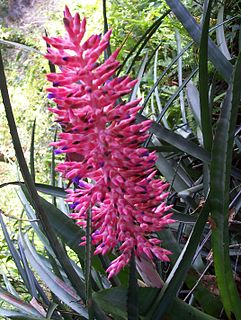
Aechmea distichantha, the Brazilian vaseplant, or vase plant, is a bromeliad typical of Cerrado vegetation in Brazil, which is also native to northern Argentina, Bolivia, Paraguay, and Uruguay. This plant is often used as an ornamental plant.

Oxypetalum is a genus of flowering plants in the family Apocynaceae, first described with this name in 1810. The genus is native to South America.
Hylodes uai is a species of frog in the family Hylodidae. It is endemic to the Espinhaço Mountains in the Minas Gerais state, Brazil, where it is known from the Mangabeiras Park in Belo Horizonte, and another location on the southern end of the Espinhaço Mountains. It is the most-inland species of the genus.

Arthropogon is a genus of South American and Caribbean bunchgrass plants in the grass family.

Dyckia leptostachya is a plant species in the genus Dyckia. This species is native to Brazil, Bolivia, Paraguay, and Argentina.
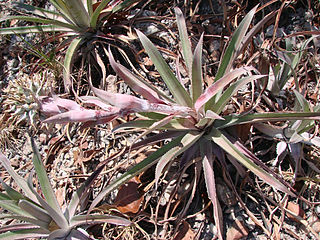
Aechmea lamarchei is a plant species in the genus Aechmea. It is endemic to eastern Brazil, known only from the States of Minas Gerais and Espírito Santo.

Constantia is a genus of flowering plants from the orchid family, Orchidaceae. It contains 6 known species, all endemic to Brazil:
- Constantia australis(Cogn.) Porto & Brade - Santa Catarina
- Constantia cipoensisPorto & Brade - Minas Gerais
- Constantia cristinaeF.E.L.Miranda - Minas Gerais
- Constantia gutfreundianaChiron & V.P.Castro - Minas Gerais
- Constantia microscopicaF.E.L.Miranda - Minas Gerais
- Constantia rupestrisBarb.Rodr. - Rio de Janeiro

Skeptrostachys is a genus of flowering plants from the orchid family, Orchidaceae. It is native to eastern South America.

Dyckia rariflora is a plant species in the genus Dyckia endemic to the State of Minas Gerais in Brazil.
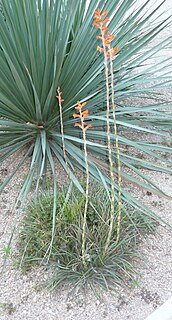
Dyckia remotiflora is a plant species in the genus Dyckia. It is native to Argentina, Uruguay, and Brazil.

The rock tapaculo or Espinhaço tapaculo is a species of bird in the family Rhinocryptidae. It is endemic to altitudes of 900–2,100 metres (3,000–6,900 ft) in the central and southern Espinhaço Mountains, and the Mantiqueira Mountains in Minas Gerais, Brazil, though it may also occur in adjacent parts of Rio de Janeiro and São Paulo. It is found in shrubby and grassy habitats in rocky regions, and in elfin and cloud forest. It closely resembles the Diamantina tapaculo and Planalto tapaculo in appearance and voice.
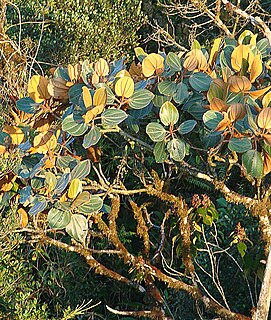
Graffenrieda is a genus of flowering plants in the family Melastomataceae. There are about 44 species. Most occur in South America. A few are distributed in Mexico, Central America and the Caribbean.

Tibouchina papyrus Toledo was described in 1952. Tibouchina papyrus is a narrow endemic to the campos rupestres and is mainly found in three localities in the states of Goiás and Tocantins in central Brazil, including the Serra da Natividade. Abreu et al. found that T. papyrus is a habitat-specialist on rocky outcrop cerrado which typically has shallow substrate and uneven topography, with sandstone soils and quartzite outcrops. This species has been collected at elevations between 500 metres and 1,100 metres. T. papyrus is listed as vulnerable by the IUCN. Tibouchinapapyrus is locally known as “pau-papel”.
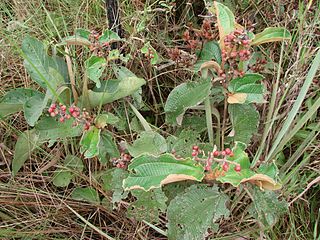
Miconia macrothyrsa is a species of shrub in the family Melastomataceae. It is native to South America.

Pterolepis is a genus of flowering plant in the family Melastomataceae. Within Melastomataceae, it forms a clade with genus Pterogastra. Pterolepis contains fourteen species, all of which are found in the Neotropical geographic realmm. Most species are concentrated in Brazil, with a few others across Central and South America.

Corythomantis galeata is a species of frog in the family Hylidae. It is endemic to Brazil and only known from its type locality near Morro do Chapéu, Bahia, in the northern part of the Espinhaço Mountains. The specific name galeata is derived from Latin and means "covered with a helmet", in reference to the co-ossified head of this frog.

Microlicia is a genus of flowering plants in the family Melastomataceae, native to northern South America, particularly Brazil. They tend to be subshrubs.

















